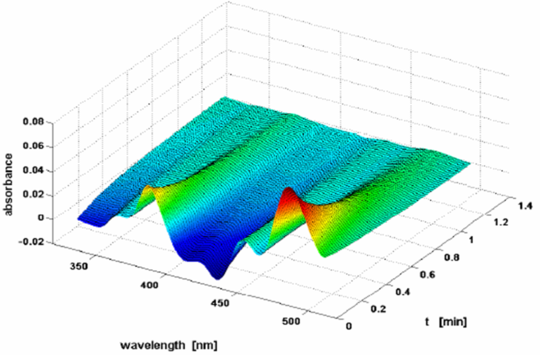B4 Light- and voltage-activated, membrane-anchored enzymes
State of the art
Controlling the catalytic activity of enzymes is one of the central goals in biocatalysis. Nature has designed a large variety of control mechanisms of impressive robustness. These systems often comprise a combination of sensory and catalytic modules, the function of which relies on concerted conformational changes induced by the sensor. From an experimental point of view, systems using sensors for light, voltage, or redox potential are most attractive, because they represent well-defined and easy-to-control input signals.
In this research field, we will study enzyme complexes consisting of a catalytic and a light- or voltage-sensor module to gain insights into the structural and dynamic aspects involved in these regulation systems. In particular, we will use phosphatases and adenylate cyclases (ACs), which catalyse the production of phosphatidyl-inositol-biphosphate (PIP2 from PIP3) and cyclic-adenosyl monophosphate (cAMP) from ATP, respectively. The sensor modules of these systems are either membrane-associated blue-light receptors (BLUF), membrane-inserted green-light receptors (rhodopsins), or voltage sensors. Even though a substantial amount of information is already known for the individual modules, the properties of the coupled systems are largely unknown.
Our research will therefore concentrate on the spatial and dynamic properties of the conformational coupling process between sensor and catalyst, which will take advantage of the fact that enzymatic activity can most conveniently be triggered and synchronized by short light pulses or voltage steps. To understand the conformational fine-tuning of catalytically active sites, these investigations require close collaboration between researchers in spectroscopy, electrophysiology and structural biology.
Research goals
The goal of the project is the understanding of enzymes & catalysts that are modulated by light or membrane voltage, beginning from the sensing of the light absorption or voltage jump via early conformational changes in the chromophore domains, towards enzyme activation, adaptation and silencing. The five-year goal is to tailor new enzymes with specific chromophore or voltage sensor properties, and with catalytic activity that will be applicable to medical science and biotechnology (Optogenetic Technology).
Results/Achievements
Elucidating the functional interactions between sensor and catalytic modules in light- and voltage-triggered enzymes (B4) relies upon novel strategies to introduce spectral probes in the interaction domain between sensor and catalysts. This expertise is now available with the recent appointment of N. Budisa for the UniCat professorship "Biocatalysis". Up to now, the studies have been restricted to the spectroscopic analysis of the sensor module as well as of model systems that allow for optimising tailored (time-resolved) spectroscopic methods and theoretical approaches. [1-4]
A breakthrough towards optogenetic applications of photosensors for controlling complex catalytic processes in cells has been recently achieved.[5] Tailored channelrhodopsin variants with optimised kinetic properties previously characterised in vitro have been introduced for studying and affecting neuronal signalling processes.[5-7] Following this remarkable success, a light-activated adenylate cyclase could be coupled with a cAMP-gated cation channel, allowing for a light-induced control of cAMP-dependent processes in vivo.[8] Optogenetic technologies were named as "Method of the Year" by the journal Nature Methods in 2010.
Most important publications
[1] R. Brosi, B. Illianorov, T. Mathes, M. Fischer, A. Bacher, P. Hegemann, R. Bittl, S. Weber, E. Schleicher; Hindered rotation of a cofactor methyl group as a probe for protein-cofactor interaction; J. Am. Chem. Soc. 2010, 132, 8935-8944.
[2] K. L. Dürr, K. Abe, N. N. Tavraz, T. Friedrich; Functional significance of E2 state stabilization by specific alpha/beta-subunit interactions of Na,K- and H,K-ATPase; J. Biol. Chem. 2009, 284, 20147-20154.
[3] M. A. Mroginski, D. von Stetten. F. Velazquez Escobar, H. M. Strauss, S. Kaminski, P. Scheerer, M. Günther, D. H. Murgida, P. Schmieder, C. Bongards, W. Gärtner, J. Maillet, J. Hughes, L. O. Essen, P. Hildebrandt; Chromophore structure of cyanobacterial phytochrome Cph1 in the Pr state: reconciling structural and spectroscopic data by QM/MM calculations; Biophys. J. 2009, 96, 4153-4163.
[4] D. von Stetten, M. Günther, P. Scheerer, D. H. Murgida, M. A. Mroginski, N. Krauß, T. Lamparter, J. Zhang, D. M. Anstrom, R. D. Vierstra, K. T. Forest, P. Hildebrandt; Chromophore heterogeneity and photoconversion in phytochrome crystals and solutions studied by resonance Raman spectroscopy; Angew. Chem. Int. Ed. 2008, 47, 4753-4755.
[5] P. Hegemann, A. Möglich; Channelrhodopsin-engineering and exploration of new optogenetic tools; Nat. Meth. 2011, 8, 39-42.
[6] A. Berndt, O. Yizhar, L. Gunaydin, P. Hegemann, K. Deisseroth; Bistable neural state switches; Nat. Neurosci. 2009, 12, 229-234.
[7] L. Gunaydin, O. Yizhar, A. Berndt, V. Sohal, K. Deisseroth, P. Hegemann; Ultrafast optogenetics: precise neural control beyond the gamma band; Nat. Neurosci. 2010, 13, 387-393.
[8] F. Zhang, M. Prigge, F. Beyrière, S. P. Tsunoda, J. Mattis, O. Yizhar, P. Hegemann, K. Deisseroth; Red-shifted optogenetic excitation: A novel tool for fast neural control derived from Volvox carteri; Nature Neurosci. 2008, 11, 631-633.
Project team and expertise
| Prof. Dr. Robert Bittl (FU Berlin) | EPR Spectroscopy |
| Prof. Dr. Nico Ernsting (HU Berlin) | Ultra-fast spectroscopy on photoreceptors |
| Prof. Dr. Peter Hildebrandt (TU Berlin) | Vibrational spectroscopy on photoreceptors |
| Prof. Dr. Thomas Friedrich (TU Berlin) | voltage-activated enzymes, electrophysiology |
| Prof. Dr. Peter Hegemann (HU Berlin) | Light-activated proteins, biochemistry and electrophysiology |
| Prof. Dr. Peter Saalfrank (Uni Potsdam) | Theory of photoreceptors |
Former team members | |
| Prof. Dr. Maria Mroginski (TU Berlin) | Calculations of vibrational spectra |
Dr. Thomas Risse | EPR Spectroscopy on surface-bond proteins |



